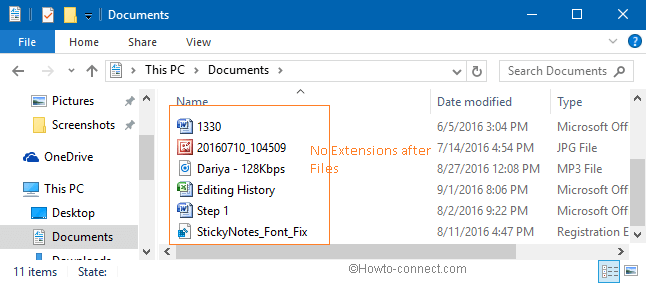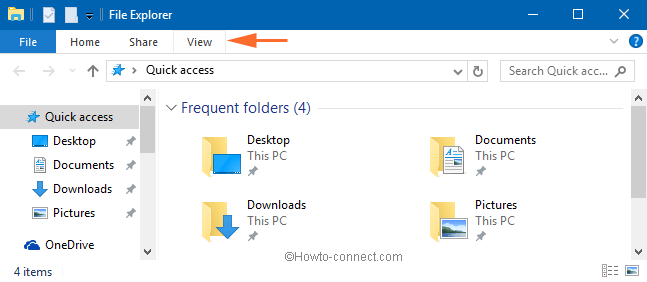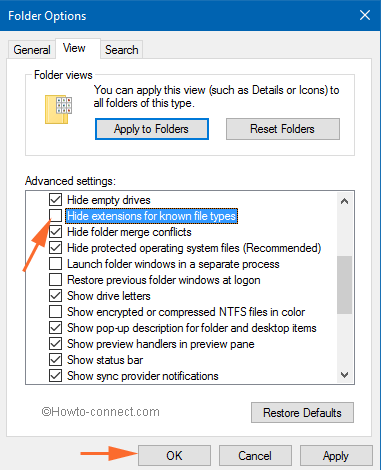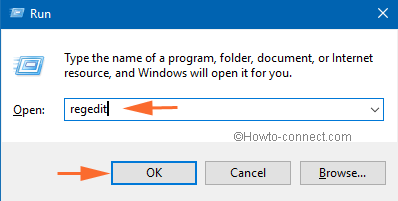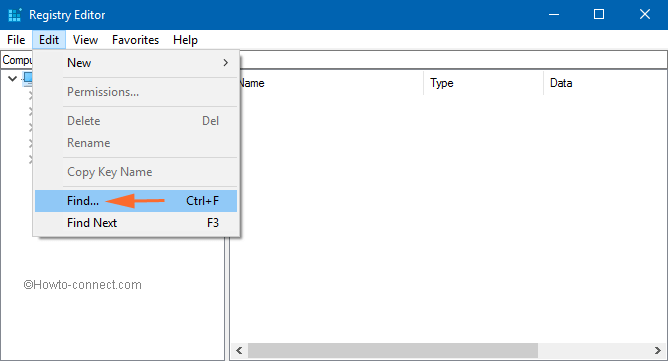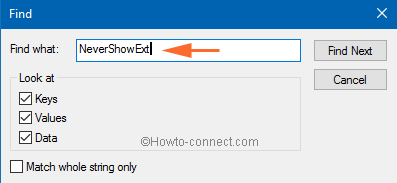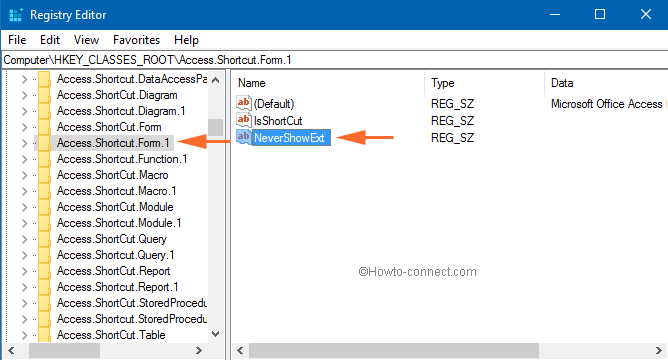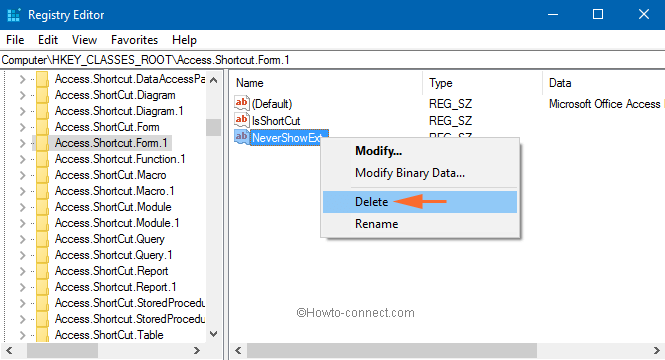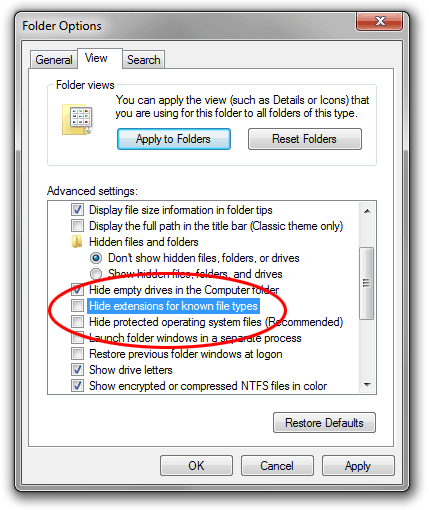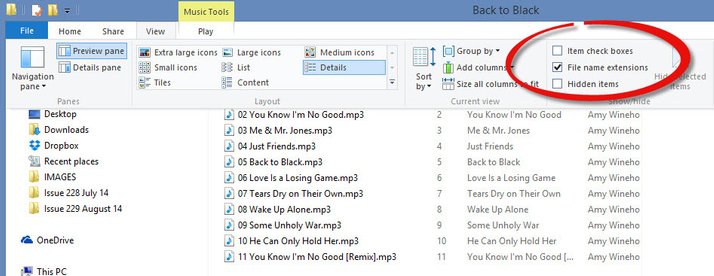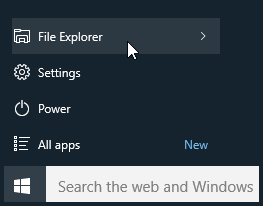- How to Add or Remove Extension of File Type in Windows 10
- How to Add Extension of File Type in Windows 10
- How to Add Hidden Extension of File Type in Windows 10 for Security Purpose
- How to Add or Remove Shortcut word after File Name in Windows 10
- Remove Shortcut word after File
- Add Shortcut word after File
- How to show File Extensions in Windows 10
- What are File Extensions & how are they useful
- Show File Extensions in Windows 10
- 1] Through Folder or File Explorer Options
- 2] Via Windows File Explorer
- 3] Using the Registry Editor
- How to change a File Extension in Windows
How to Add or Remove Extension of File Type in Windows 10
In this tutorial, you will read How to Add or Remove Extension of File Type in Windows 10. You will come across three sections in this post where the first will have the tips to display the file type extensions for the known files. The second section consists the steps to add the Hidden file extensions. And the last section will guide you to add or remove Shortcut name (prefix) extension in shortcut created files in Windows 10.
What Are File Name Extensions?
You find a group of characters at the end of each of your Files everywhere. This could be .jpg, or .png, or .doc or .txt or any other. These are none other than File Name Extensions and tell that which types of files these are.
Why Are File Name Extensions so important?
When you meet a malicious threat the main thing you need to know is which type of file is damaging your PC so that you can rectify the issues or take a precautionary measure to avoid this kind of attack in the future. So, Microsoft should make this feature available by default because as the extensions are hidden you will never get to know the file type. But I infer they have emphasized on the clean interface rather than security.
You may like to read:
How to Add Extension of File Type in Windows 10
Just like previous editions, Windows 10 also refuses to show Extension of File Type in Windows 10 of the known files by default. The main reason of the hidden file extensions is to refrain user’s mind from confusion with the exhibition of different types of extension. But Windows 10 always gives you the chance to display the file extensions like avi, doc, exe, mp3, txt and a lot more.
Steps to follow:
- Open This PC.
- On the top, click View.
- A new ribbon arrives. Take your attention to the extreme right corner of the ribbon and click Options.
- A new window of Folder Options arrives on your screen.
- Get into the View tab.
- Beneath the Advanced settings section, go to the Hide extensions for known file types option.
- Clear the checkbox of the option and click Apply and Ok buttons.
- Now, you can see the file extensions of the known files.
After the completion of the above process, Windows starts showing the Extension of File Type in Windows 10 and you can easily figure out the individual file type.
How to Add Hidden Extension of File Type in Windows 10 for Security Purpose
After you clear the checkbox Hide extensions for known file types in Folder Options, Windows 10 will display most of the file extensions leaving behind some of the system reserved file extensions like URL (internet shortcuts), lnk (file shortcuts). These file extensions are not displayed in File Explorer and are tucked away by default through Registry keys.
NeverShowExt is the Registry key which when set for any Extension of File Type in Windows 10 in Registry Editor, disallows the same file extension to display in File Explorer. There are certain file extensions which are always kept hidden in File Explorer. They are –
URL (Internet Shortcut)
PIF (MS-DOS Program Shortcut)
SCF (Windows Explorer Command)
SHS (Shell Scrap Object)
SHB (Document Shortcut)
XNK (Exchange Folder Shortcut)
The above-referred file types hold NeverShowExt strings in the Registry Editor which restrict them from displaying their file extensions. And hence, this type of behavior brings harm to your computer. Suppose anyone creates a harmful program and change its name to example.txt.url. And as per Windows nature, the URL extension will not be shown and you would assume it to be a txt file and attempt to open it and thus brings threats to your computer. So, your big concern would be to solve the problem.
For the hidden file types, you need to remove the NeverShowExt string in Registry Editor and then only you can see the file extensions.
- Hit Windows and R keys cumulatively to see the Run command dialog box.
- Type Regedit and press Enter key.
- If UAC prompts up, click Yes button.
- Click Edit followed by Find in the menu bar.
- Or you can also use the shortcut keys Ctrl + F.
- A Find box appears now.
- In the Find what space, type NeverShowExt and hit Enter.
- The search begins and the first string of NeverShowExt will be demonstrated in the Registry Editor window.
- In Registry Editor, you will see many NeverShowExt strings but you are advised to delete the strings of the preferred keys. Take precautions before deleting the strings because you might see it in other types like the library, account picture, and things like that.
- So before deleting, take a backup of the respective key. Right-click on the key and choose Export.
- Now, get to the right pane of the key and select NeverShowExt string and hit Delete key or right-click on the string and click Delete option.
- To see the next available NeverShowExt string, press F3 key.
- Delete the string of the key if needed.
- After the process is over, restart your Windows 10 computer and see the file extensions.
How to Add or Remove Shortcut word after File Name in Windows 10
When you perform a right-click on a folder, file or even a drive, the context menu displays you some of the commands. If you choose to select Create shortcut or Send to Desktop commands, a shortcut of the same folder, file or drive will be created in the Desktop and it will exhibit the filename along with the Shortcut word (prefix) at its end. You can add or remove it.
You need to download .bat file to either add or remove the Shortcut word after the afresh created shortcuts.
Remove Shortcut word after File
- Click the below link and download the file.
- Try to save the .bat file in an easily navigated location.
- Get to the location where you have saved it and double click on the .bat file.
- Now, your screen will blink. Create a new shortcut and you can see the Shortcut name extension is turn on.
Note: This is turned on by default.
Add Shortcut word after File
- Download the .bat file from the following link.
- Go to the downloaded file and double click the .bat file.
- Here also your screen will blink. Create a new shortcut to see if the Shortcut name extension is still on or not.
Note: The changes are applied to the shortcuts created after turning on or off the Shortcut name extension. Shortcut name extension of the shortcuts created prior to the change will not be affected.
How to show File Extensions in Windows 10
File Extension is that which identifies the file type. If you are a regular Windows user, then it is not at all a problem to identify the file type. For it is very important to see file extension to identify the type of file you are trying to open from a security point of view. So in this post, we will see how to hide or show File Extensions in Windows 10/8/7 and why you should show them.
Since file names allow you to use multiple full stops, the real name of a malware file could be realword .docx.exe . But because you have not set Windows to show file extensions, you would see only realword .docx . Thinking its a Word document, you could well end up clicking on it and infecting your computer. If you had, on the other hand, set your PC to show file extensions, you would see its full name – realword .docx.exe , which would help you to identify that it was actually an executable file and in all probability a malware file.
What are File Extensions & how are they useful
Different file types have different extensions. Audio files have .mp3, .wav, .wma, and more based on the program used to open that file. File extensions also help the operating system to identify the corresponding program to open that particular file. So, you should be able to see file extensions to be at the safer side, and we will let you know how to enable options to see file extensions in Windows.
As mentioned earlier, by default Windows does not show file extensions and they are hidden. But, you can toggle the option to see them.
Show File Extensions in Windows 10
There are five ways how you can go about accessing this setting:
- Through the File Explorer Options
- Through Windows Explorer Ribbon
- Using the Registry
- Using Command Prompt
- Using Group Policy Editor.
1] Through Folder or File Explorer Options
Open Control Panel > Appearance and Personalization. Now, click on Folder Options or File Explorer Option, as it is now called > View tab.
In this tab, under Advanced Settings, you will see the option Hide extensions for known file types. Uncheck this option and click on Apply and OK.
Windows 10 users may also search for File Explorer Options in Start search box and open this box.
Now, you can see file extensions for all files anywhere on your Windows system.
In Windows 10/8.1 Explorer, you can access File Explorer Options via Explorer.
Click View > Options > Change folder and search options.
Once here, you can do the needful as explained above.
In Windows 7, open Explorer, press Alt on your keyboard to make the Classic bar appear. Next, click on Tools > Folder Options. Now follow the steps mentioned above.
These are very simple steps to follow, and you do not need any third-party software to view file extensions. Windows provides us with everything which can be easily achieved, and the point lies in knowing and implementing them. This is the first way to see file extensions in Windows 7.
2] Via Windows File Explorer
Open Explorer and click on the View tab. Simply select the File name extensions checkbox, and you are all set.
3] Using the Registry Editor
Hit the WINKEY + R button combination to launch the Run utility, type in regedit and hit Enter. Once Registry Editor opens, navigate to the following key-
Look up for a DWORD entry labeled as HideFileExt.
Double click on the mentioned DWORD entry and set its value as 0. This will show up the hidden file extensions.
A value of 0 will hide the file extensions.
Exit the Registry Editor and then reboot your computer for the changes to take effect.

4] Use Windows Command Prompt
This fix can be used in both the scenarios mentioned above. Insert a bootable drive of Windows 10 installer.
Start by hitting the WINKEY + X combinations and select Command Prompt (Admin) to launch Command Prompt with Administrator Privileges.
Navigate to the root location of that bootable device inside the Command Prompt command line. Once you get there, type in the following to show the file extensions-
And then hit Enter.
You can also enter the following command to hide the file extensions,
5] Using Group Policy Editor
You can also use the Group Policy Editor and change the setting here:
User Configuration > Preferences > Control Panel Settings > Folder Options.
Set “Show hidden files and folders” and uncheck “Hide extensions for known file types”.
Thus, you can set your Windows to show file extensions in Windows 10/8. If you have anything to add, please do share it with us through comments.
Date: March 22, 2020 Tags: Explorer, Features
How to change a File Extension in Windows
This article outlines how to change a file extension in Windows. For example, you might want to rename a TURF file called MCALL_0110_4865_6500_2074._ip to MCALL_0110_4865_6500_2074.zip
These instructions are for Windows 7 but the same basic process applies to most versions of Windows.
By default, Windows hides file extensions. In order to change them, you must first unhide file extension to make them visible so they can me changed. Then you can change it.
If you can already see file extensions on your computer, skip to Step 2
How to show file extensions in Windows 7
Step 1: If you can’t see the file extension, Open Windows Explorer and click on the Organize button towards the top left. Then choose Folder and Search Options, then click the View tab. Uncheck the box titled «Hide extensions for known file types» like so:
Click OK. Now you should be able to see the file extension.
How to show file extensions in Windows 8
Step 1: It’s simple to turn file extensions on and off in Windows 8. Simply open a File Explorer window (the new name for Windows Explorer) and click the View tab.
Now check the box next to File name extensions. If the box is check, extensions will be shown. If unchecked, they won’t. This is the opposite way the tickbox works in Windows 7 and Vista.
How to show file extensions in Windows 10
Step 1: Open the File Explorer by clicking on the Windows Start button and selecting the File Explorer icon as shown below.
Click the View tab in File Explorer and then click the Options button (or click the drop down menu and click Change folder and search options) as shown below.
The Folder Options dialog box is displayed. Click the View tab at the top of Folder Options as shown below
To view file extensions, uncheck the Hide extensions for known file types option.
Click OK when done.
Step 2: Right-click the file name and select Rename (or left-click and hold down the button for one second). Enter the new extension like so:
After entering the new extension hit the Enter (return) key. Windows will give you a warning that the file may not work properly. This is quite safe—remember that you can restore the original extension if anything goes wrong.
It’s also possible that you might get another message telling you that the file is «read-only». In this case either say yes to turning off read-only or right-click the file, select Properties and uncheck the Read-only box.
If you do not have permission to change the file extension, you may have to log in as Administrator. Another option is to make a copy of the file, rename the copy and then delete the original.
